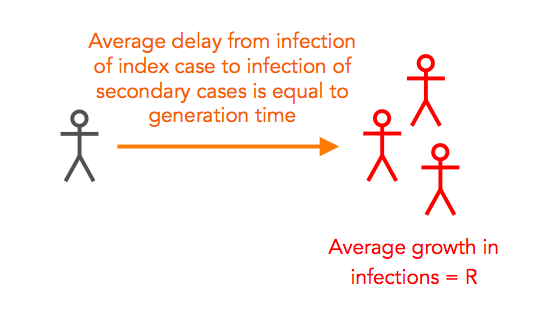Is the reproduction number currently 0.7, or 0.85, or 0.641? Was it bigger yesterday than today? A thread on real-time estimation and false precision... 1/
Most real-time estimation of R involves looking at the ratio of change from one generation of infection to the next (which takes about 5 days on average: https://www.eurosurveillance.org/content/10.2807/1560-7917.ES.2020.25.17.2000257).">https://www.eurosurveillance.org/content/1... In reality, however, we rarely see the moment of infection, we just see cases appearing later... 2/
So the first task is to work out data to use. Should we estimate R from cases, or hospitalisations, or deaths? The answer, of course, is we should look at all these data sources, noting that each has different delays we need to account for 3/
Because most of these delays occur over a period of several days, and people are infectious for several days, it generates statistical uncertainty that makes precise daily estimates of R very difficult... 4/
One way to deal with the time issue is to use real-time social contact data (e.g. https://bmcmedicine.biomedcentral.com/articles/10.1186/s12916-020-01597-8)">https://bmcmedicine.biomedcentral.com/articles/... to measure how people are currently interacting, and hence estimate R. But we should still validate these estimates against other data sources such as case curves. 5/
There& #39;s also the issue of setting-specific transmission. Community transmission is currently low in many European countries, with outbreaks centred on healthcare and care homes. This means current case data doesn& #39;t mean what it meant two months ago. 6/
R is also an average value, so it doesn& #39;t make sense to focus on R when case counts get very low, because transmission is driven by super-spreading events, which become disproportionately important when infection numbers are small https://twitter.com/AdamJKucharski/status/1245336637497913345">https://twitter.com/AdamJKuch... 7/
In summary: we generally have to estimate R from multiple datasets, each with its own notable uncertainties. So don& #39;t expect a highly precise estimate of R, or one that will change in an easily measurable way from day-to-day. 8/
There& #39;s more about R estimation methods on the @cmmid_lshtm epiforecasts page ( https://epiforecasts.io/covid/ ).">https://epiforecasts.io/covid/&qu... 9/
Final technical note: if cases are under-reported, it doesn& #39;t affect R estimation as long as under-reporting is consistent (because R uses the ratio of change). However, detection is now improving in many countries, so need to be extra-cautious about interpreting R 10/10

 Read on Twitter
Read on Twitter


